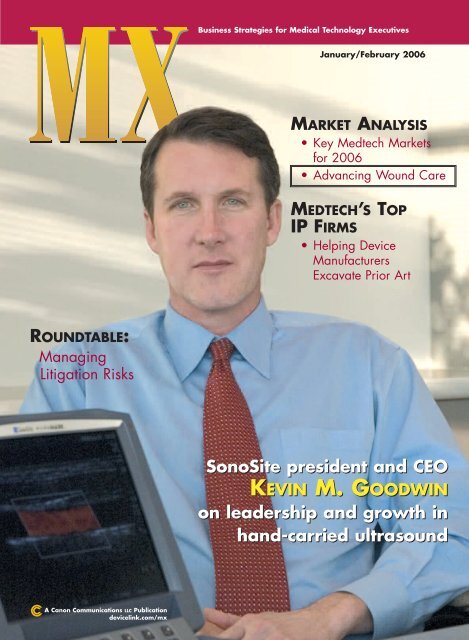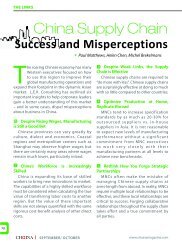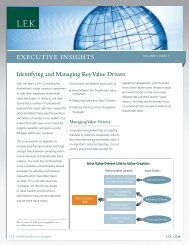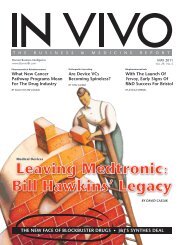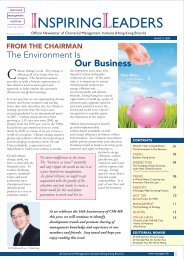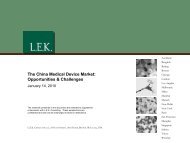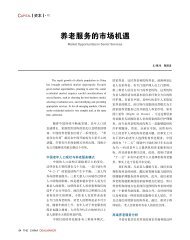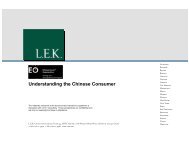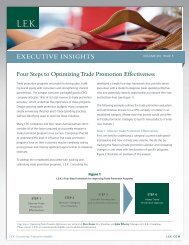The Future of Wound Care - LEK Consulting
The Future of Wound Care - LEK Consulting
The Future of Wound Care - LEK Consulting
You also want an ePaper? Increase the reach of your titles
YUMPU automatically turns print PDFs into web optimized ePapers that Google loves.
ROUNDTABLE:<br />
Managing<br />
Litigation Risks<br />
A Canon Communications LLC Publication<br />
devicelink.com/mx<br />
Business Strategies for Medical Technology Executives<br />
January/February 2006<br />
MARKET ANALYSIS<br />
• Key Medtech Markets<br />
for 2006<br />
• Advancing <strong>Wound</strong> <strong>Care</strong><br />
MEDTECH’S TOP<br />
IP FIRMS<br />
• Helping Device<br />
Manufacturers<br />
Excavate Prior Art<br />
SonoSite president and CEO<br />
KEVIN M. GOODWIN<br />
on leadership and growth in<br />
hand-carried ultrasound
M ARKET ANALYSIS<br />
<strong>The</strong> <strong>Future</strong><br />
<strong>of</strong> <strong>Wound</strong> <strong>Care</strong><br />
Active products represent an area <strong>of</strong> huge potential<br />
growth for medical device manufacturers.<br />
Stuart Jackson and Jeffrey Stevens<br />
<strong>Wound</strong> care costs the<br />
U.S. healthcare system<br />
more than $20<br />
billion each year,<br />
including more than<br />
$4 billion spent on wound management<br />
products. Chronic and severe<br />
wounds, the most difficult wounds to<br />
heal, have been the focus <strong>of</strong> significant<br />
product innovation in recent<br />
years. Yet despite this innovation,<br />
unmet clinical and commercial needs<br />
persist.<br />
Physicians and patients are looking<br />
for improved treatment options<br />
that heal wounds effectively, minimize<br />
complications, and shorten hospital<br />
stays. <strong>The</strong> potential to reduce<br />
overall costs to the healthcare system<br />
is a further motivating factor. Now, a<br />
new class <strong>of</strong> products is emerging to<br />
better address these unmet needs.<br />
Active wound care products, many<br />
<strong>of</strong> which combine the advantages<br />
<strong>of</strong> medical devices with those <strong>of</strong><br />
pharmaceuticals, promise to redefine<br />
“best medicine” for treating chronic<br />
and severe wounds.<br />
Active wound care products are<br />
used to treat approximately 2 million<br />
wounds in the United States annually<br />
(see Figure 1). This is less than 20%<br />
<strong>Wound</strong>s per year (millions)<br />
14<br />
12<br />
10<br />
8<br />
6<br />
4<br />
2<br />
0<br />
Diabetic<br />
ulcers/amputations<br />
Trauma/surgery<br />
73% 10% 30% 12%<br />
<strong>Wound</strong> type<br />
Figure 1. <strong>The</strong> potential for advanced and active wound care therapies in the U.S. wound care<br />
market. Percentages indicate the implied penetration rate <strong>of</strong> the therapies.<br />
<strong>of</strong> the wounds that they could treat.<br />
New product introductions, greater<br />
physician awareness, expanded thirdparty<br />
reimbursement, greater regulatory<br />
clarity, and continued pro<strong>of</strong> <strong>of</strong><br />
safety and efficacy will drive growth<br />
<strong>of</strong> 23% for the active wound care segment<br />
through 2009 (see Figure 2).<br />
<strong>The</strong> increasing popularity <strong>of</strong> active<br />
wound care products will have many<br />
winners: the medtech industry will<br />
benefit from market expansion, doc-<br />
Venous ulcers<br />
Pressure ulcers<br />
Total wounds<br />
<strong>Wound</strong>s treated with<br />
advanced or active therapies<br />
Burns<br />
8%<br />
Total<br />
17%<br />
tors will have enhanced treatment<br />
options, patients will gain better outcomes,<br />
and payers will see lower overall<br />
costs due to reductions in hospital<br />
stays.<br />
But although the rewards in this<br />
market could be substantial, there are<br />
also strategic challenges. Given the<br />
nature <strong>of</strong> active products, medical<br />
device companies will likely need to<br />
share the spotlight with pharmaceutical<br />
and biotechnology firms. This
may require creative partnerships<br />
in research and development,<br />
manufacturing, and sales and<br />
marketing, as well as new, coordinated<br />
approaches to regulatory<br />
affairs, reimbursement, and intellectual<br />
property. In the end, if the<br />
pace <strong>of</strong> innovation continues<br />
and strategic challenges can be<br />
addressed, active wound care will<br />
be the next big growth area in<br />
medical devices.<br />
An Evolving Market<br />
<strong>The</strong> market for wound care<br />
products has evolved in three<br />
overlapping phases (see Figure 3),<br />
with caregiver techniques generally<br />
keeping pace. Today, treatment<br />
options include traditional, advanced,<br />
and active products.<br />
Traditional Products. Traditional<br />
products—those that treat wounds<br />
with dry bandages and dressings—<br />
account for more than 50% <strong>of</strong> the<br />
chronic and severe wound care market<br />
today. Since many wounds can be<br />
healed with products that do nothing<br />
more than cover and protect the<br />
wound from infection, traditional<br />
products will remain an important<br />
alternative in the physician’s arsenal.<br />
On the whole, the traditional<br />
wound care segment is mature, and<br />
Phase 1:<br />
Traditional<br />
wound care<br />
Cover and<br />
protect<br />
wound<br />
Dry bandages,<br />
adhesives,<br />
and dressings<br />
Sales<br />
($ billions)<br />
6<br />
5<br />
4<br />
3<br />
2<br />
1<br />
Active 23%<br />
Advanced 10%<br />
Traditional –2%<br />
0<br />
2004 2005 2006 2007 2008 2009<br />
Figure 2. Projected sales <strong>of</strong> traditional, advanced,<br />
and active wound management products in the<br />
United States, 2004–2009. Percentages indicate<br />
the compound annual growth rate <strong>of</strong> each sector.<br />
total sales are expected to decline by<br />
2% per year through 2009. Part <strong>of</strong><br />
this decline will be attributable to a<br />
lack <strong>of</strong> new product innovation. <strong>The</strong><br />
features and benefits <strong>of</strong> tomorrow’s<br />
sponges, nonadherent and conforming<br />
bandages, abdominal pads, and<br />
other traditional products will be<br />
virtually indistinguishable from<br />
today’s dressings.<br />
From a competitive standpoint,<br />
large suppliers such as Johnson &<br />
Johnson’s Ethicon Inc. (Somerville,<br />
NJ), Bristol-Myers Squibb’s Conva-<br />
Tec (Skillman, NJ), Smith & Nephew<br />
(London), Tyco International’s<br />
Kendall Co. (Mansfield, MA), 3M<br />
(St. Paul, MN), and others are large-<br />
Promote<br />
moist<br />
environment<br />
Phase 2:<br />
Advanced<br />
wound care<br />
Moisture agents,<br />
hydrocolloids,<br />
foams,<br />
hydrogels,<br />
and alginates<br />
Cover and<br />
protect<br />
wound<br />
Improved<br />
dry bandages,<br />
dressings,<br />
and devices<br />
ly focused on improving product<br />
quality and increasing product line<br />
breadth. In addition, products are<br />
becoming increasingly commoditized<br />
and price points are generally expected<br />
to fall. For medium and smaller<br />
suppliers, these dynamics suggest a<br />
bumpy road ahead (see sidebar, page<br />
41). While consolidation is likely,<br />
there is little fear <strong>of</strong> a dramatic market<br />
shakeout. Most competitors can<br />
survive, but margins will be under<br />
pressure and excess pr<strong>of</strong>its will be difficult<br />
to achieve. While traditional<br />
products will remain important,<br />
evolving medical practice is shifting<br />
the market toward newer alternatives.<br />
Advanced Products. Advanced<br />
products promote a moist environment,<br />
thereby accelerating healing <strong>of</strong><br />
many difficult-to-treat or chronic<br />
wounds. Substances that help provide<br />
ideal moisture conditions include<br />
hydrogels, hydrocolloids, foams, and<br />
alginates. Unlike the traditional segment,<br />
the advanced segment is far<br />
from mature. Total sales in the<br />
advanced wound care segment are<br />
expected to grow more than 10%<br />
annually through 2009.<br />
Many <strong>of</strong> the large players in traditional<br />
wound care are also active<br />
in the advanced segment. Alongside<br />
them are more than 200 smaller companies,<br />
approximately 40% <strong>of</strong> which<br />
Moist<br />
environment<br />
Moisture agents<br />
Phase 3:<br />
Active<br />
wound care<br />
Protect<br />
Dry bandages,<br />
dressings,<br />
and devices<br />
Stimulate<br />
healing<br />
Active agents<br />
(biologics,<br />
cell engineering, etc.)<br />
Figure 3. <strong>The</strong> evolution <strong>of</strong> the wound care product market from traditional dry dressings to active products that treat wounds and<br />
promote healing.
have annual revenues <strong>of</strong> less than $15<br />
million. Large and small competitors<br />
alike stand to reap substantial benefit<br />
from double-digit market growth<br />
over the next several years. Some <strong>of</strong><br />
this growth will come from market<br />
expansion, which will be driven by<br />
the treatment <strong>of</strong> patients who historically<br />
could not be treated with<br />
traditional products.<br />
Beyond this, growth will come at<br />
the expense <strong>of</strong> traditional products,<br />
as advanced products are increasingly<br />
used as first-line therapy. In the<br />
past, physicians might only have<br />
turned to advanced products after<br />
traditional products failed. Now,<br />
advanced products are being used<br />
earlier and more <strong>of</strong>ten. Understanding<br />
how such clinical pathways will<br />
evolve and predicting the impact on<br />
specific products and suppliers<br />
should be a focus <strong>of</strong> all companies<br />
in this market.<br />
Underlying patient demographics<br />
will accelerate the trend toward<br />
advanced products. <strong>The</strong> rising incidence<br />
<strong>of</strong> diabetes, for example, will<br />
translate into more diabetic ulcers<br />
and amputations, the wound types<br />
for which advanced products have<br />
seen greatest market penetration to<br />
date. Similarly, the aging U.S. population<br />
will yield more cases <strong>of</strong> venous<br />
ulcers, which tend to occur in older<br />
people with poor lower-extremity<br />
circulation, and pressure ulcers,<br />
which are most common in the<br />
bedridden elderly. With age,<br />
decreased cellular function lessens the<br />
body’s natural ability to close and heal<br />
wounds, so wounds in the elderly are<br />
<strong>of</strong>ten better candidates for advanced<br />
products. As patient demographics<br />
change, suppliers may need to shift<br />
their sales and marketing efforts to<br />
better target clinical decision makers<br />
and decision influencers, both by<br />
practitioner type and by site <strong>of</strong> care.<br />
Why won’t advanced product<br />
segment growth be even greater? One<br />
medical challenge with advanced<br />
products is that a precise level <strong>of</strong><br />
moisture must be maintained to prevent<br />
the problem <strong>of</strong> excess exudate<br />
Thoughts for Smaller Companies<br />
interfering with the healing process.<br />
This requires a lot more work to treat<br />
the wound, hence increased immediate<br />
cost <strong>of</strong> patient care.<br />
Another factor limiting growth<br />
for advanced products is that traditional<br />
products are adequate for many<br />
wounds. If a simple dry bandage or<br />
dressing can heal a wound, practitioners<br />
may prefer that less laborintensive<br />
and cheaper option. In these<br />
cases, payers find it difficult to justify<br />
the higher prices <strong>of</strong> advanced products.<br />
For other wounds, suppliers<br />
need to educate the healthcare community<br />
on advanced products’ longterm<br />
value proposition, including<br />
significant savings from reduced<br />
hospital visits. Especially useful would<br />
be compelling data on cost per<br />
quality-adjusted life year. 1<br />
Finally, growth in the advanced<br />
segment is expected to be constrained<br />
by the next and newest phase <strong>of</strong><br />
wound care evolution: active products<br />
have emerged onto the scene.<br />
Active Products. <strong>The</strong> active<br />
wound care segment is anticipated to<br />
grow 23% per year through 2009.<br />
Active products administer substances<br />
to the wound that contribute<br />
to repair either by delivering bioac-<br />
M ARKET ANALYSIS<br />
Smaller suppliers <strong>of</strong> traditional wound care products will face a bumpy road<br />
in light <strong>of</strong> the expected sales decline in this sector over the coming years.<br />
For those looking to maintain or increase their pr<strong>of</strong>it margins, innovative<br />
product development in the advanced or active wound care markets is the<br />
appropriate focus.<br />
When products near or reach launch, establishing a strategic partnership<br />
with a larger player is <strong>of</strong>ten a good option. This is especially true<br />
if the smaller company has a broad intellectual property portfolio and a<br />
pipeline <strong>of</strong> products in development, in which case a partnership can be<br />
struck for product- or market-specific rights while rights to broader assets<br />
are retained.<br />
If capital is available or can be raised, however, smaller companies may<br />
want to resist the partnering option. By remaining independent through<br />
product launch and early sales ramp-up, substantial value can be built.<br />
Once products have been validated by the marketplace, an initial public<br />
<strong>of</strong>fering or a sale <strong>of</strong> the company becomes increasingly viable, and partnerships<br />
remain an option. For many medical device companies, corporate<br />
value is highest after product approval and demonstrated sales, but before<br />
peak sales are reached. Pursuing an exit too early is likely to result in leaving<br />
money on the table, but waiting too long can yield a similar result.<br />
tive compounds or by utilizing materials<br />
that facilitate the body’s own<br />
ability to heal. This is a step beyond<br />
providing a moist healing environment.<br />
<strong>The</strong> substances used range<br />
from relatively low-tech collagen to<br />
high-tech artificial growth factors<br />
that catalyze the wound healing<br />
process, and biosynthetic materials<br />
that act as scaffolds for delivery.<br />
One <strong>of</strong> the most advanced active<br />
wound care techniques is tissue engineering,<br />
the ultimate goal <strong>of</strong> which is<br />
the replacement <strong>of</strong> tissue, whole or<br />
cellular. Other technologies, such as<br />
“living” stem cell bandages, are in<br />
development. Today, companies such<br />
as LifeCell Corp. (Branchburg, NJ)<br />
are leading the pack with active<br />
tissue-regeneration products, including<br />
a deconstructed version <strong>of</strong> human<br />
skin that can be transplanted without<br />
fear <strong>of</strong> rejection. LifeCell has established<br />
sales and marketing partnerships<br />
with Boston Scientific (Natick,<br />
MA), Stryker Corp. (Kalamazoo, MI),<br />
Wright Medical Group (Arlington, TN),<br />
and BioHorizons (Birmingham, AL).<br />
Not all active wound care products<br />
involve cell engineering or<br />
biotechnology agents. <strong>The</strong>rapies such<br />
as Kinetic Concepts’ (San Antonio,
MARKET ANALYSIS<br />
<strong>The</strong> VAC Instill system by Kinetic Concepts Inc. (San<br />
Antonio, TX) promotes healing through vacuumassisted<br />
closure technology, an example <strong>of</strong> active<br />
wound care.<br />
TX) vacuum-assisted closure technology,<br />
a noninvasive wound closure<br />
system that uses controlled, localized<br />
negative pressure to promote healing,<br />
are also helping to transform<br />
wound care. 2 Advances in related<br />
fields such as nanotechnology are further<br />
accelerating innovation.<br />
Nanocrystalline silver-based wound<br />
care products, one <strong>of</strong> the world’s first<br />
medical applications <strong>of</strong> nanotechnology,<br />
broaden and extend the<br />
decades-old use <strong>of</strong> silver to include<br />
antiinflammatory activity.<br />
<strong>The</strong> overall drivers <strong>of</strong> growth in<br />
active products are similar to those in<br />
advanced products. By taking wound<br />
care to a new level <strong>of</strong> efficacy and<br />
treating wounds that could not be<br />
treated before, these products will<br />
grow the overall market. Further market<br />
expansion will come as physicians<br />
employ active products in treatment<br />
regimens that include traditional<br />
products, advanced products, or<br />
other active products, thereby increasing<br />
the total number <strong>of</strong> treatments<br />
for a given patient base. Evolving<br />
clinical pathways and underlying<br />
patient demographics will also contribute<br />
to active product growth.<br />
If the full potential <strong>of</strong> active products<br />
is to be achieved, targeted sales<br />
and marketing efforts, peerreviewed<br />
literature, and other<br />
initiatives will be required to<br />
improve physician awareness<br />
and convince the medical<br />
community that these products<br />
<strong>of</strong>fer unique clinical benefits.<br />
Pharmaceutical and medical<br />
technology companies will<br />
need to work together to<br />
achieve this.<br />
Collaboration will also be<br />
important in research and<br />
development for medical technology<br />
companies that lack<br />
biologics capabilities. Pharmaceutical<br />
companies are an<br />
option, as are biotechnology<br />
start-ups hungry to access the<br />
marketing savvy, operational<br />
infrastructure, and capital they<br />
lack. Collaborators will need to<br />
carefully address issues such as sharing<br />
<strong>of</strong> intellectual property rights, and<br />
will need to allow for a coordinated<br />
approach to sales and marketing.<br />
Ultimately, because many active<br />
products combine drugs with devices,<br />
the historically separate evolution <strong>of</strong><br />
these therapeutic modalities needs to<br />
converge on a common future path.<br />
From a regulatory standpoint, the<br />
combination <strong>of</strong> two distinct components—medical<br />
device and active<br />
healing agent—that would normally<br />
be regulated under different authorities<br />
has complicated the situation.<br />
Determining the primary regulatory<br />
jurisdiction and subsequent authorities<br />
for hybrid products is done on<br />
a case-by-case basis. Of particular<br />
interest to regulators are products<br />
that comprise living cells or tissues.<br />
Further, the outcome <strong>of</strong> clinical<br />
trials for wound care can fluctuate<br />
substantially. Because wounds vary<br />
in size, depth, and complications,<br />
truly controlled trials are elusive.<br />
Companies in the active wound<br />
care segment will need to clarify what<br />
data constitute approvable clinical<br />
trial endpoints.<br />
Active wound care market participants<br />
also face uncertainty regarding<br />
existing reimbursement structures,<br />
and will need to work with thirdparty<br />
payers and managed-care entities<br />
to prove favorable cost-benefit<br />
pr<strong>of</strong>iles relative to other alternatives.<br />
Into the <strong>Future</strong><br />
Despite significant wound care<br />
advances, unmet needs remain. Many<br />
wounds cannot be optimally healed<br />
even with the latest products and clinical<br />
techniques. All wound care market<br />
participants must stay focused<br />
on the ever-advancing technology<br />
horizon.<br />
<strong>Future</strong> innovations, particularly<br />
drug-device combinations, will create<br />
expansion opportunities for some<br />
and obsolescence risk for others. <strong>The</strong><br />
newest active products promise crosstalk<br />
in the wound environment to<br />
dynamically control which growth<br />
factors and wound-regulatory elements<br />
are activated, and at what time.<br />
<strong>The</strong> future <strong>of</strong> wound healing is a<br />
directed process that provides moreeffective<br />
tissue regeneration than has<br />
ever before been possible. As the<br />
wound care market continues to<br />
evolve, active products will remain at<br />
the forefront <strong>of</strong> best medicine,<br />
redefining patient care and garnering<br />
substantial market growth.<br />
It is interesting to compare the<br />
outlook for wound care with the evolution<br />
that the cardiovascular market<br />
has undergone. <strong>The</strong> direct and indirect<br />
costs <strong>of</strong> cardiovascular disease<br />
and stroke have expanded from $60<br />
billion in 1997 to approximately $400<br />
billion today. With these spiraling<br />
costs have come larger market opportunities<br />
for many suppliers. Underlying<br />
patient demographics and better<br />
diagnosis have played a role, but<br />
pharmaceutical and medical device<br />
company innovations have also been<br />
critical to expanding their respective<br />
segments. Entire new product classes<br />
have been created, <strong>of</strong>ten at the<br />
expense <strong>of</strong> those that came before.<br />
One lesson to be taken from this<br />
is that market growth can total more<br />
than the sum <strong>of</strong> separately evolving<br />
segments. This is largely because<br />
Photo courtesy Kinetic Concepts
physicians tend to employ overlapping<br />
drug and device therapies for a<br />
given patient. Research conducted by<br />
L.E.K. <strong>Consulting</strong> shows that anticoagulants<br />
and angioplasty are used<br />
in 70% and 66% <strong>of</strong> coronary artery<br />
thrombosis cases, respectively—that’s<br />
136% usage, or almost 1.4 treatments<br />
per patient, not counting the myriad<br />
other therapeutic alternatives<br />
employed. Another lesson is that<br />
drug-device convergence can create<br />
value for all market participants.<br />
Drug-eluting stents, for example,<br />
once a holy grail <strong>of</strong> the industry, are<br />
now a reality. Benefits to suppliers,<br />
physicians, patients, and payers are<br />
increasingly clear.<br />
Conclusion<br />
<strong>Wound</strong> care is big business—and<br />
it is only getting bigger. <strong>The</strong>re are<br />
large companies in the market, but<br />
none has yet achieved clear market<br />
dominance. This is especially true in<br />
the advanced and active segments,<br />
where innovations are occurring at<br />
an accelerating pace. Competition<br />
will be increasingly price-based in the<br />
traditional segment, but in advanced<br />
products, differentiation will be the<br />
key to success.<br />
Manufacturers in the active product<br />
segment will need to be especially<br />
mindful <strong>of</strong> the importance <strong>of</strong> crossdisciplinary<br />
device-pharma-biotech<br />
collaborations, the risks inherent in<br />
choosing the wrong partner, and the<br />
rewards <strong>of</strong> partnering with the right<br />
company. In the intermediate to long<br />
term, increased merger and acquisition<br />
activity is likely as competitors<br />
seek to create a one-stop shop with<br />
traditional, advanced, and active<br />
wound care products under a single<br />
ro<strong>of</strong>.<br />
Applying lessons from the evolution<br />
<strong>of</strong> cardiovascular devices to<br />
wound care underscores the prediction<br />
for overall market expansion and<br />
rapid growth in some segments. Volumes<br />
will trend upward as products<br />
heal wounds that could not be healed<br />
before and physicians employ multiple<br />
products to treat the same patient.<br />
<strong>The</strong> premium prices commanded<br />
by newer products will supplement<br />
M ARKET ANALYSIS<br />
volume growth, particularly when<br />
changing clinical pathways position<br />
these as first-line therapies.<br />
Ultimately, active device-drug<br />
combination products will be the<br />
biggest beneficiaries. At currently<br />
anticipated growth rates, active<br />
wound care will represent a more<br />
than $1 billion opportunity within<br />
the next five years in the United<br />
States. If even a couple <strong>of</strong> the more<br />
exciting innovations in the pipeline<br />
materialize, then the market’s<br />
growth could easily surpass these<br />
expectations.<br />
References<br />
1. M Martinson and R Brekke, “Demonstrating<br />
Value to Payers,” MX 5, no. 5 (2005): 40–47.<br />
2. “Growing Public,” [Cover story, interview with<br />
Dennert O Ware, president and CEO <strong>of</strong> Kinetic<br />
Concepts] MX 5, no. 2 (2005): 30–36.<br />
Stuart Jackson is vice president and head <strong>of</strong><br />
the Chicago <strong>of</strong>fice <strong>of</strong> L.E.K. <strong>Consulting</strong> and<br />
leads the firm’s international medical<br />
device practice. Jeffrey Stevens, a partner<br />
in Chicago, is a senior member <strong>of</strong> the<br />
medical device practice. ■<br />
About L.E.K. <strong>Consulting</strong><br />
Executives seeking to establish competitive advantage and deliver value creating growth <strong>of</strong>ten find a need for strategic<br />
advice supported by fact-based, rigorous analysis. As one <strong>of</strong> the world’s most successful strategy consulting firms,<br />
L.E.K. <strong>Consulting</strong> provides clients with a comprehensive range <strong>of</strong> services that deliver compelling and practical solutions<br />
to their most challenging, highest-value problems and opportunities.<br />
<strong>The</strong> common theme in all <strong>of</strong> our work is to provide clients the information and insights they need to move confidently<br />
and to achieve superior performance and outstanding returns. Whether from the Fortune 500 or emerging<br />
companies, senior executives turn to L.E.K. for guidance when they are confronted with complex challenges amid<br />
dynamic change. Since being founded in 1983, L.E.K. has expanded to 16 international <strong>of</strong>fices with 70 partners and<br />
over 650 consulting pr<strong>of</strong>essionals drawn from premier schools and leading corporations, giving L.E.K. the experience<br />
and expertise critical to helping clients achieve and exceed their strategic goals.<br />
L.E.K. <strong>Consulting</strong> collaborates with medical device companies to target the steps necessary to realize improved<br />
patient outcomes and increased shareholder value, including identifying attractive growth opportunities, developing<br />
or acquiring products that deliver increased value to patients, and launching new products to achieve growth and value.<br />
For further information, please contact Stuart Jackson, Vice President and Medical Device Practice Leader, at<br />
s.jackson@lek.com. www.lek.com<br />
Reprinted from MX, January/February 2006, Copyright © 2006 Canon Communications LLC


